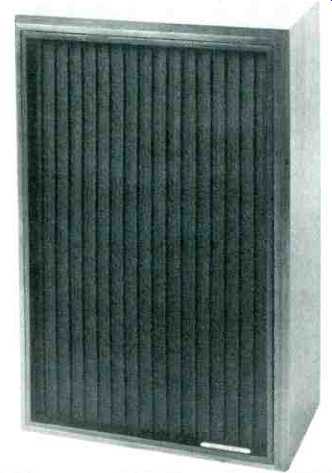
MANUFACTURERS SPECIFICATIONS:
Bass unit: 12 inch, 8-spoke cast aluminum frame, 12,500 gauss flux, 4.175 inch voice coil. Integral heat sink in 12 lb. magnet.
Mid-range: 5 inch, 1 inch voice coil.
Mounted in sub-enclosure.
High Frequency: 3 Electrostatic elements.
System impedance: 8 ohms nominal.
Finish: Walnut or rosewood.
Dimension: 27 by 17 by 12 1/4 inches deep.
Shipping weight: 175 lbs.
Price: $850 a pair in Oiled Walnut, $950 in Rosewood.
The SAE Mk. XII is a most ambitious bookshelf system--and at $850 a pair it must be one of the most expensive too! The bass unit is unusually massive with its cast aluminum frame and 17 lb. magnet structure. A huge 4 inch voice coil is used and the coil former is black anodized. Figure 1 shows a cut-away section, note the double spider assembly and rigid cone. The mid-range speaker is a 5 inch dynamic with 1.75 lb. magnet and high frequencies are handled by a 3-panel electrostatic array which radiates to the rear as well as forward. In other words, a dipole. Crossover frequency is given as 1440 Hz. Low frequency crossover points are switchable giving a choice of 120, 240 or 480 Hz and level controls are provided for both midrange and high frequency units. A very elaborate protection circuit disconnects the loudspeakers if triggered by supersonic oscillations, d.c. voltage or severe overload signals. Three transistors are employed in this circuit and an indicator light warns the listener that something is amiss and that the speaker has been switched off. The crossover and protection assembly is shown in Figure 2. It is mounted at the rear as it contains the input terminals and level controls.
The enclosure is sealed and system resonance is a low 38 Hz. The cabinet is available in rosewood or walnut and the grille cloth is detachable.
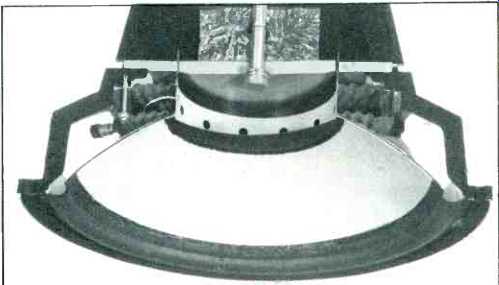
Fig. 1--Cut-away section of bass speaker.
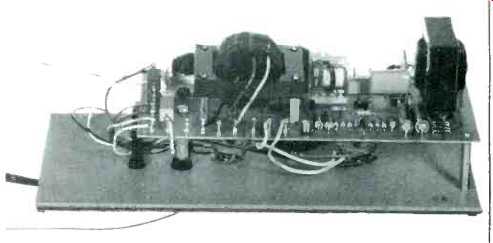
Fig. 2--Crossover and protection circuit assembly.
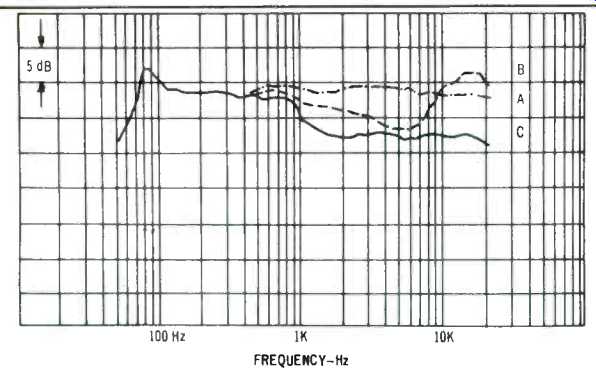
Fig. 3--Frequency response taken with one-third octave pink noise. A was
measured on-axis, B at 30 degrees and C at 60 degrees off-axis.
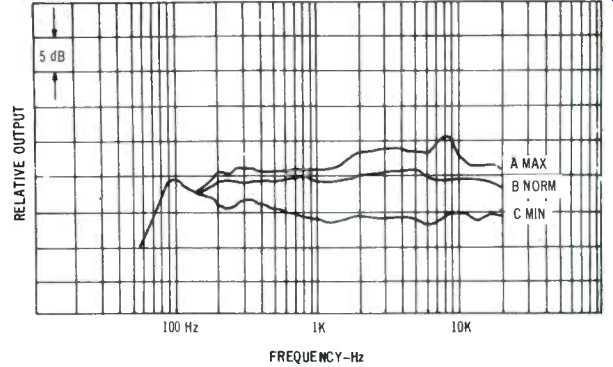
Fig. 4--Range of mid-range and high frequency level controls.
Measurements
Figure 3 shows the frequency response taken with one-third octave pink noise. A was measured on-axis, B at 30 degrees and C at 60 degrees off-axis. Figure 4 shows the range of the mid and high frequency controls. All these measurements were made with the low frequency crossover set at 480 Hz. The two lower frequencies, 120 and 240 Hz merely introduced a dip in the response as the midrange range is not extended downward. We doubt whether this particular option is really worthwhile although it could be argued that a crossover might reduce the effects of standing waves if the speakers were stood in the corner of a room. Tone burst responses at 100, 500 and 5,000 Hz are given in Figure 5. The low frequency response shows a sharp recovery and freedom from hangover and the high frequency pulse shows the effect of multiple reflections. Impedance characteristics are shown in Figure 6 and it will be seen that the lowest point is a fraction under 4 ohms with the mid-range control at maximum. Low frequency distortion and SPL figures are given in Figure 7. The system would take a continuous sine wave input of 42 watts at 40 Hz without distress, 59 watts at 70 Hz and 168 watts at 100 Hz. White noise tests showed a slight coloration mainly due to the reflections or diffraction from the cavity in which the ESL units are mounted. It was not considered serious and we ought to emphasize that we are being more than usually critical having regard to the price and complexity of the system.
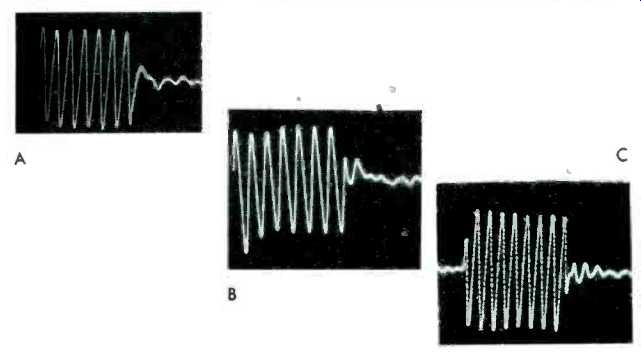
Fig. 5-Tone-burst responses. A is 100 Hz, B 500 Hz and C 5,000 Hz.
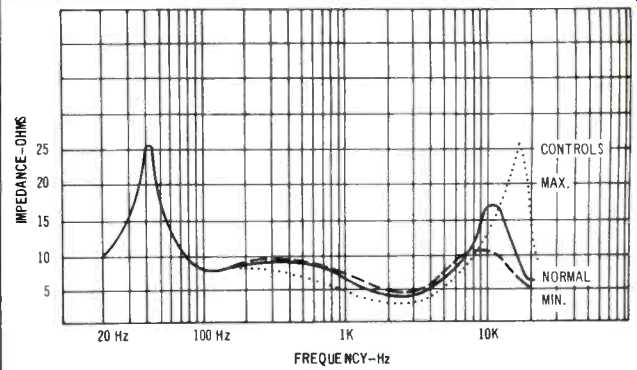
Fig. 6-Impedance characteristics.
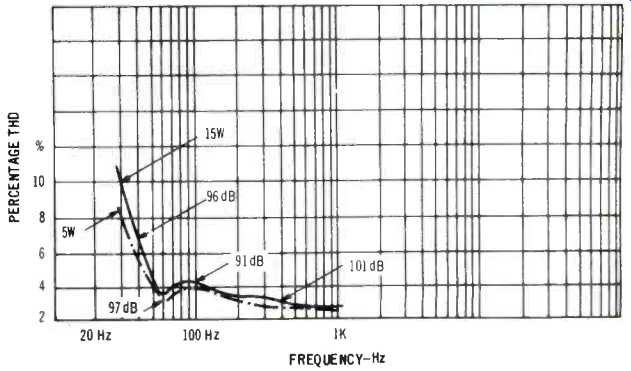
Fig. 7-Low frequency distortion and SPL figures.
Listening Tests
Sensitivity is somewhat lower than average and SAE recommend a minimum power of 60 watts per channel.
For most of the tests we used a Sony 1130 and a new Phase Linear 400 was pressed into service later. The 1130 gave ample power for a fairly large room and the Phase Linear just loafed along with plenty of power to spare. A 1,000 Hz sine wave activated the protection circuit at about 150 watts and the red light duly came on. Removal of the signal brought the speaker back into circuit after 5 seconds. These indicator lights can be seen through the grille cloth--red showing that the protection circuit is operating and amber confirming that the power supply is switched on.
With the controls at maximum the sound had a slightly forward quality and we found the best position for both was just above the " Normal" level. Best place for the systems was about 3 feet from the floor and placed a foot or so from the wall. Other positions were tried (not without some unaccustomed effort as the systems turn the scales at 160 lbs. a piece!) In some locations they may be stood on the floor; this was fine in the lab but in the larger listening room, the bass tended to be over-prominent-especially if the systems were placed near the corners.
Having arrived at the optimum positions for systems and controls we put the Mk XII through some severe tests--including direct speech recordings and some top-quality 15 ips tapes. Overall sound was spacious with the typical electrostatic transparency coupled with the solid bass of the massive 12 inch woofer. Speech was natural without that chesty coloration and there was no trace of low frequency hangover. Perhaps SAE will now design another system with the ESL crossing over at 400 Hz or thereabouts. Unfortunately it will have to be larger than the Mk XII and more expensive too!
--G. W.T.
(Audio magazine, May 1973)
Also see:
SAE Model 2922 Integrated Amplifier (Mar. 1979)
SAE Mk IIICM Basic Amplifier (Equip. Profile, Jan. 1975)
SAE Model 5000 Impulse Noise Reduction System (June 1977)
Robertson Sixty Ten Amplifier (Jan. 1986)
= = = =